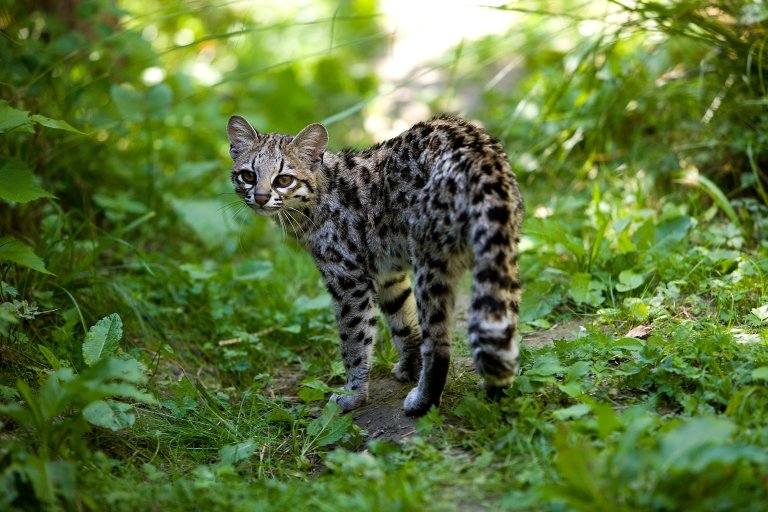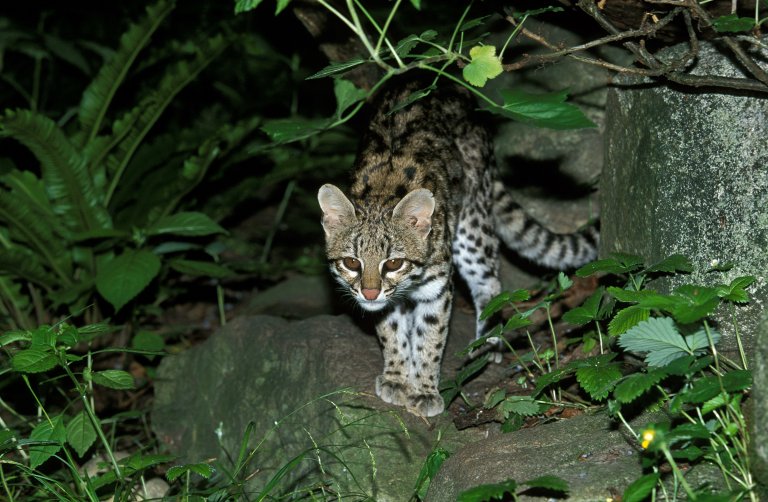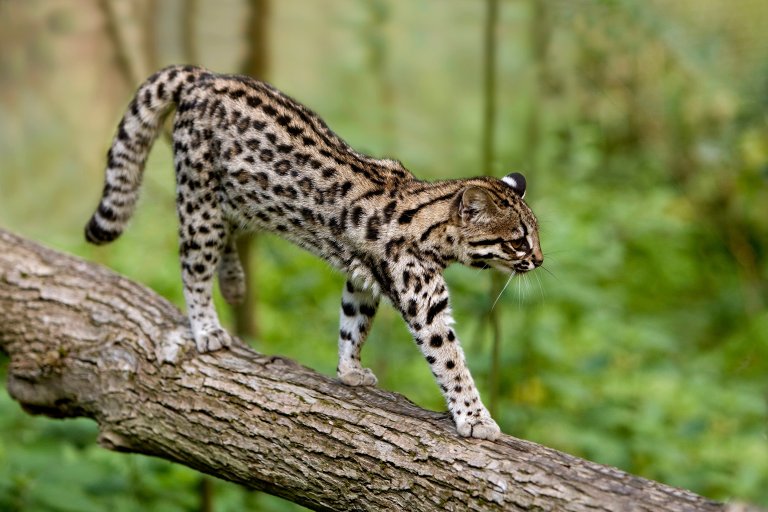Oncilla Profile
The oncilla is an elusive, small cat species found in central and South America. Also known as the ‘little spotted cat’ or ‘tiger cat’, they are smaller than the more well-known ocelot and margay, but share the same habitat.
Found most commonly in heavily forested areas, they are known to inhabit savannah, wetland and cloud forest ecosystems. Even in areas where they have been recorded in relatively high numbers, this small cat is both difficult to see and there have been few studies of them in the wild.
As oncillas share the same habitat as larger cats, they are more reclusive and avoid larger animals whenever they can.

Oncilla Facts Overview
| Habitat: | Dense forests, savannah and mountainous regions |
| Location: | Central and South America, from Costa Rica down to Northern Argentina |
| Lifespan: | 12 years in the wild |
| Size: | Length 90cm including the tail. Height 20cm |
| Weight: | 2.5kg |
| Color: | Coat is yellow to dark brown with randomly spaced dark rosettes. Tail is darkly ringed |
| Diet: | Carnivorous; feeding mainly on rodents but also eating lizards and birds |
| Predators: | Little known but possibly preyed upon by larger cats |
| Top Speed: | 61 kph (38 mph) |
| No. of Species: |
1 |
| Conservation Status: |
Vulnerable |
Oncillas have a short, heavily patterned coat that helps them blend in with their surroundings. Their coat varies from a light yellow to dark brown color, covered with dark spots or rosettes and their undercoat is paler. The tail of an oncilla is just over half as long as it’s body length and covered with several dark rings.
Perhaps unsurprisingly for a cat, the oncilla is a skilled climber. However as most of their prey is found on the ground, the oncilla spends most of its time prowling through the long grass and vegetation of the forest floor. Most populations of oncilla are nocturnal, hunting small mammals that also forage in the dark. Where oncillas are found in drier areas, they may spend more time hunting during the day, especially when lizards are out bathing in the sunshine. They are generally opportunistic hunters, the oncilla will survey the area from vantage points in trees so as to identify potential prey.
It is thought that oncillas live a fairly solitary life, only coming together by chance or to mate. They produce small litters and usually only one kitten is born in a litter. The young will only stay with their mother until they around 4 months old and only reach sexual maturity at over 2 years old.
This small litter size and the time taken to reach sexual maturity means that oncillas have a very low reproductive rate and this may partly explain why these beautiful cats are rare in almost all of their range.
Oncillas have very few natural predators but in areas where the larger ocelot or jaguarundi are common, they tend to be found in far fewer numbers. Due to their excellent climbing ability, the oncilla is able to flee from potential predators or foes by dashing up trees, either hiding there or moving from one tree to the next.
Though the oncilla is both agile and able to remain hidden, they can be extremely aggressive and will fight animals larger than themselves when cornered.
Despite being less well known compared to their larger cousins, oncillas still play a vital role in the ecosystem; their natural affinity for hunting rodents keeping rodent populations to sustainable limits.
Even though they are shy cats, habitat destruction and the presence of larger carnivores often forces them to live closer to human habitation than they would naturally. They are considered ‘vulnerable’ by the IUCN redlist.
Interesting Oncilla Facts
1. Oncillas are easily confused with the ocelot and the margay
Even small cat specialists have a difficult time telling these small cats apart.
Though the oncilla is smaller with a slender build, their similar coats, behaviour and habitat preference can make correct identification of an oncilla a tough task!
Oncilla are the smallest wild cats in South America, with a body length between 1-2 feet. This is longer than the average domestic cat, but they can often weigh less.1

2. There might be two species of oncilla
Recently scientists have discovered that the oncilla may actually consist of two separate species; the Northern and the Southern tiger cat.
Though the two apparent species show little difference in appearance and also share the same habitat, it has been suggested that they are unable to interbreed.
The oncilla or Northern tiger cat has now been given the scientific name Leopardus tigrinus, and the Southern tiger cat referred to as Leopardus guttulus. 2
3. Oncillas can live in areas higher than 3,200m above sea level
In mountainous areas within their range, oncillas are able to inhabit the cold cloud forests, possibly avoiding competing with other cats.
4. They are becoming more common in man-made habitats
Where their preferred habitat of dense forest is either populated by larger cats or has been disturbed in some way, oncillas will occupy eucalyptus forests and drier areas which is testament to their adaptability.

5. Oncilla parents show very little parental care
Once an oncilla kitten has weaned at around 4 months, the mother will play an almost non-existent role in her young’s survival. The father plays no role in caring for his offspring.
6. They have a large home range for cats of their size
Due to their extremely solitary nature Oncillas can have a home range of up to 17 km2, much larger than cats of a similar size.
7. Melanism is relatively common in oncillas
Melanistic or completely black individuals make up about one fifth of the population in some areas.
8. Their colour and pattern helps them blend in with their surroundings
An oncilla’s yellow to brown coat and dark rosettes mix perfectly with the dappled sunlight and forest vegetation, keeping them well hidden.

9. In certain areas their main food source are lizards
In more arid regions in which the oncilla is found, they have adapted to a more diurnal lifestyle so as to prey upon the lizards which require the sun to warm their bodies.
In other regions, they’ll eat small mammals, birds, eggs and tree frogs.
10. The oncilla is a very ‘clean’ predator
As with most wild cats, oncillas are efficient killers. They usually kill their prey instantly with a bite to the back of the skull.

11. They are excellent swimmers
The oncilla has also been observed swimming and seems to be very comfortable crossing smaller bodies of water.
12. Oncilla fur was once a very sought after commodity
Unfortunately for oncillas, their beauty led to a great demand for their coats for use in the fur trade. Luckily restrictions on the use of fur in fashion has somewhat reduced this.
They are listed on CITES Appendix I, prohibiting all international commercial trade, however they are still poached for their pelts and hunting of oncilla is still permitted in Ecuador, Guyana, Nicaragua and Peru. 3
Oncilla Fact-File Summary
Scientific Classification
| Kingdom: | Animalia |
| Phylum: | Chordata |
| Class: | Mammalia |
| Order: | Carnivora |
| Family: | Felidae |
| Subfamily: | Felinae |
| Genus: | Leopardus |
| Species Name: |
Leopardus Tigrinus |
Fact Sources & References
- Tadeu Oliveira (2004), “The oncilla in Amazonia: unraveling a myth“, ResearchGate.
- Ed Yong (2013), “Sneaky Spotted Cat Has Been Disguised As Another Species“, National Geographic.
- “Tigrina or Oncilla“, Big Cat Rescue.
